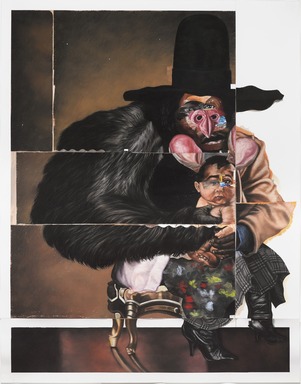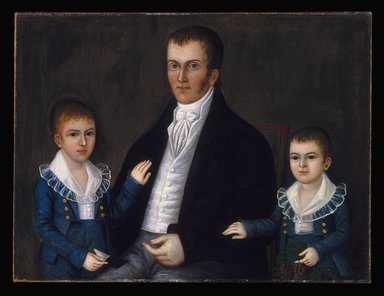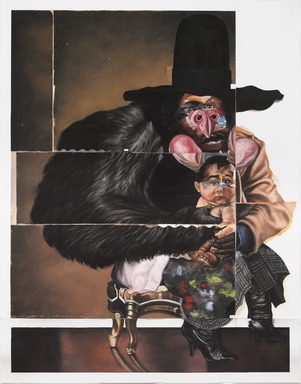[ad_1]

Nathaniel Mary Quinn, Big Rabbit, Little Rabbit, 2017.
COURTESY BROOKLYN MUSEUM
When Linda Goode Bryant was planning to open Just Above Midtown, her storied gallery, in 1974, the artist Romare Bearden told her, “Linda, to start a gallery you’re going to have to have $50,000.”
“That was an absurdity!” she said of that number, while onstage at the Brooklyn Museum on Thursday night. Her response back then: “Well, I don’t have $50,000, so we’re going to have to start it on whatever I can get.” That turned out to be a $2,000 loan from Citibank.
Bryant made it work, though, and what transpired is now the stuff of legend. During its 12 years in operation, the gallery on 57th Street in Manhattan became a vital laboratory for venturesome African-American artists and other artists of color, including David Hammons, Senga Nengudi, Lorraine O’Grady, and others. In 2022, the Museum of Modern Art will dedicate a show to Just Above Midtown, the next in a handful of exhibitions that have looked at the legacy of that seminal space and the artists it fostered.
Bryant was present, imparting history and inspiration and dishing stories, as part of the latest event in the Brooklyn Museum’s regular series “Breaking the Canon,” which addresses the institution’s collecting of African-American art. This one was loosely focused on pre-1945 art in the field, and had a crisp tripartite format, pairing each of three black artists with a different curator—in Bryant’s case, Catherine Morris, senior curator of the museum’s Elizabeth A. Sackler Center for Feminist Art—for short talks on their practices, art history, and quite a bit more.
As rain poured outside, an ebullient Nathaniel Mary Quinn kicked off the affair with Eugenie Tsai, the Brooklyn Museum’s senior curator of contemporary art, discussing his work Big Rabbit, Little Rabbit (2017), which just entered the museum’s collection. It’s a fantastical, fractured double portrait of his father holding the artist as a child on his lap. The high-heeled shoes the older man appears to be wearing, Quinn said, are a reference to his mother being the family’s primary breadwinner.
“Everything first begins with a vision that comes to me,” Quinn said. “Every work I make starts like that, with a vision. There’s no overthinking.” He said he wants “to explore the very essence of humanity in my work and make reflections of who we really are—not on the outside but on the inside.” Asked about inspirations, he listed Neo Rauch, Adrian Ghenie, Kerry James Marshall, Liu Xiaodong, and Lucian Freud (who “paints flesh onto canvas”). He also praised the Brooklyn Museum’s 1941 Jacob Lawrence gouache of two men sitting in a bar, for being able to capture its subjects, and the feel of the Depression, “by means of the most minimalistic forms.”

Lucy T. Pettway, “Housetop”—Single-Block “Half-Log Cabin” Variation, c. 1945.
COURTESY SOULS GROWN DEEP FOUNDATION
Quinn, who is 41, recently started working with Gagosian, and Tsai asked what he has planned for his gallery show in Beverly Hills in September. “I’m being honest—here’s the truth,” he said. “It’s how I really feel, and I’m just going to say it. I look forward to making the best possible show that I can make, and I know that I am going to fail miserably.”
“I seriously doubt that,” Tsai said, to laughter from the crowd.
“But you try because you hope to someday make a good work,” Quinn continued, “and on a scale of 1 to 10—10 being perfect, 1 being horrific—it has to be like a 7 for the work to leave the studio, and it’s always a 6.8, 6.9.” (Regrettably, as he said this, I could not get a good look at the face of the Gagosian director I spotted in the crowd.) Quinn said he openly risks failure—he even welcomes it. “This is what you have to do if you ever expect to make at least one good piece. You have to give up everything.”
Next up was Eric N. Mack—a star of the current Whitney Biennial who also has a spare, free-flowing installation of fabric-based works on view at the Brooklyn Museum—in conversation with Ashley James, the assistant curator of contemporary art who organized the latter presentation. They started out discussing a recent acquisition by the museum—a brilliantly hued 1945 housetop-pattern quilt by Lucy T. Pettway, a member of the famed quilting community in Gee’s Band, Alabama. Mack, who is 32, talked about how the work addresses “repetition and rhythm and also making space for rupture.”
Mack’s work is marked by generous restraint and quiet, careful choices—slices of textiles stitched together, dyed, subtly altered. At one point in the talk, he quoted the late, great artist Robert Reed: “With found objects, you can get a lot for free.” In some cases, Mack said, he wants to allow “for the fabrics themselves to speak—you know, wherever I found it, whatever the viewer brings to it, to allow that to also be true.”
Discussing the contradictions he likes to have in play in his work, Mack added: “The fabric frays, but that doesn’t mean that it’s fragile.”

Joshua Johnson, John Jacob Anderson and Sons, John and Edward, 1812–15.
COURTESY BROOKLYN MUSEUM
Bryant closed out the night, with Morris interspersing bits of the museum’s history. The earliest work in the collection by an African-American artist, Morris said, is a family portrait from ca. 1812–15 by Joshua Johnson, and the first historical (as opposed to contemporary) work by an African-American woman to enter the collection was a 1939 Loïs Mailou Jones portrait, acquired in 2012.
Now 69, Bryant has spent time working at museums, running Just Above Midtown, and making documentary films, and she now operates Project EATS, a nonprofit that provides access to healthy food for urban communities (an initiative she has described, as she did JAM, as an artwork). All of her work has come from the experience of “being in something you’re not of,” she said. In those situations, she has always asked herself if it’s possible “to shift this thing that I’m in but not of so that I’m more of it.”
While discussing her long career, Bryant recalled the difficulty of finding childcare in the early 1970s. When administrators at City College told her that she shouldn’t bring her two young children to graduate-school classes, she replied, “Are you trying to tell me that because I’m a single mom I can’t get a graduate degree?” Perhaps sensing a lawsuit in the offing (though that hadn’t been her intention), she said, the administrators backed down, and people pitched in to help.
Bryant also said that, when applying for a graduate internship at the Metropolitan Museum of Art, she told everyone with whom she interviewed that she wanted “to burn the motherfucker down.” She said, “The whole point was: This is a racist institution that is living on public money that does not show the work of most of the people—the variety and the diversity of the people in the city or the United States or the world—and that shouldn’t be.” Her message to the Met was: “Be responsible, motherfuckers. Be responsible.”
She got the internship, and later became a fellow there, but she recalled that the storied curator Henry Geldzahler was not a fan of her children being at the museum. “For some reason it just irritated the hell out of him,” she said. Imitating a sputtering Geldzahler, she continued, “Ooo, those babies! Ooo, you’ve got those babies.”
“I’d say: Just relax, Henry. Relax.”
One through-line in Bryant’s diffuse work is an unrelenting drive to create vital new projects—a gallery for artists of color, a food program—that is coupled with a clear-eyed sense of pragmatism. If you can only get $2,000 to start an art gallery, you build the walls yourself. If you can’t find someone to care for your children, you bring them with you.
“The materials I use are the resources that are right in front of me,” Bryant said.
More than once she repeated what should to be a mantra for artists, museum administrators, and anyone else who is afraid of change: “It works out. No one dies.”
[ad_2]
Source link

